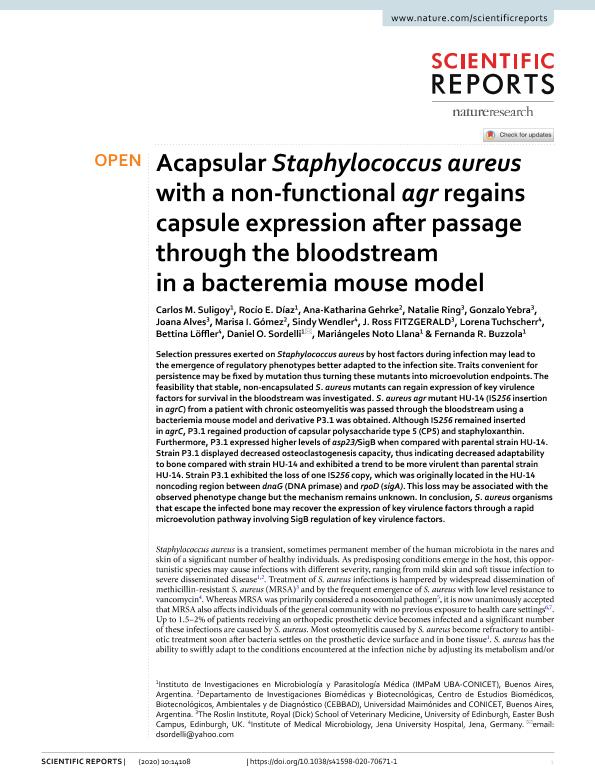Mostrar el registro sencillo del ítem
dc.contributor.author
Suligoy Lozano, Carlos Mauricio

dc.contributor.author
Díaz, Rocío E.
dc.contributor.author
Gehrke, Ana-katharina Elsa

dc.contributor.author
Ring, Natalie
dc.contributor.author
Yebra, Gonzalo
dc.contributor.author
Alves, Joana
dc.contributor.author
Gómez, Marisa Ileana

dc.contributor.author
Wendler, Sindy
dc.contributor.author
Fitzgerald, J. Ross
dc.contributor.author
Tuchscherr, Lorena
dc.contributor.author
Löffler, Bettina
dc.contributor.author
Sordelli, Daniel Oscar

dc.contributor.author
Noto Llana, Mariangeles

dc.contributor.author
Buzzola, Fernanda Roxana

dc.date.available
2022-02-10T10:17:37Z
dc.date.issued
2020-08
dc.identifier.citation
Suligoy Lozano, Carlos Mauricio; Díaz, Rocío E.; Gehrke, Ana-katharina Elsa; Ring, Natalie; Yebra, Gonzalo; et al.; Acapsular Staphylococcus aureus with a non-functional agr regains capsule expression after passage through the bloodstream in a bacteremia mouse model; Nature; Scientific Reports; 10; 1; 8-2020; 1-12
dc.identifier.issn
2045-2322
dc.identifier.uri
http://hdl.handle.net/11336/151722
dc.description.abstract
Selection pressures exerted on Staphylococcus aureus by host factors during infection may lead to the emergence of regulatory phenotypes better adapted to the infection site. Traits convenient for persistence may be fixed by mutation thus turning these mutants into microevolution endpoints. The feasibility that stable, non-encapsulated S. aureus mutants can regain expression of key virulence factors for survival in the bloodstream was investigated. S. aureus agr mutant HU-14 (IS256 insertion in agrC) from a patient with chronic osteomyelitis was passed through the bloodstream using a bacteriemia mouse model and derivative P3.1 was obtained. Although IS256 remained inserted in agrC, P3.1 regained production of capsular polysaccharide type 5 (CP5) and staphyloxanthin. Furthermore, P3.1 expressed higher levels of asp23/SigB when compared with parental strain HU-14. Strain P3.1 displayed decreased osteoclastogenesis capacity, thus indicating decreased adaptability to bone compared with strain HU-14 and exhibited a trend to be more virulent than parental strain HU-14. Strain P3.1 exhibited the loss of one IS256 copy, which was originally located in the HU-14 noncoding region between dnaG (DNA primase) and rpoD (sigA). This loss may be associated with the observed phenotype change but the mechanism remains unknown. In conclusion, S. aureus organisms that escape the infected bone may recover the expression of key virulence factors through a rapid microevolution pathway involving SigB regulation of key virulence factors.
dc.format
application/pdf
dc.language.iso
eng
dc.publisher
Nature

dc.rights
info:eu-repo/semantics/openAccess
dc.rights.uri
https://creativecommons.org/licenses/by/2.5/ar/
dc.subject
STAPHYLOCOCCUS AUREUS
dc.subject
CHRONIC INFECTION
dc.subject
CAPSULE
dc.subject
SIGB
dc.subject.classification
Biología Celular, Microbiología

dc.subject.classification
Ciencias Biológicas

dc.subject.classification
CIENCIAS NATURALES Y EXACTAS

dc.title
Acapsular Staphylococcus aureus with a non-functional agr regains capsule expression after passage through the bloodstream in a bacteremia mouse model
dc.type
info:eu-repo/semantics/article
dc.type
info:ar-repo/semantics/artículo
dc.type
info:eu-repo/semantics/publishedVersion
dc.date.updated
2021-09-07T18:53:37Z
dc.identifier.eissn
2045-2322
dc.journal.volume
10
dc.journal.number
1
dc.journal.pagination
1-12
dc.journal.pais
Reino Unido

dc.description.fil
Fil: Suligoy Lozano, Carlos Mauricio. Consejo Nacional de Investigaciones Científicas y Técnicas. Oficina de Coordinación Administrativa Houssay. Instituto de Investigaciones en Microbiología y Parasitología Médica. Universidad de Buenos Aires. Facultad de Medicina. Instituto de Investigaciones en Microbiología y Parasitología Médica; Argentina
dc.description.fil
Fil: Díaz, Rocío E.. Consejo Nacional de Investigaciones Científicas y Técnicas. Oficina de Coordinación Administrativa Houssay. Instituto de Investigaciones en Microbiología y Parasitología Médica. Universidad de Buenos Aires. Facultad de Medicina. Instituto de Investigaciones en Microbiología y Parasitología Médica; Argentina
dc.description.fil
Fil: Gehrke, Ana-katharina Elsa. Consejo Nacional de Investigaciones Científicas y Técnicas; Argentina. Universidad Maimónides. Área de Investigaciones Biomédicas y Biotecnológicas. Centro de Estudios Biomédicos, Biotecnológicos, Ambientales y de Diagnóstico; Argentina
dc.description.fil
Fil: Ring, Natalie. University of Edinburgh; Reino Unido
dc.description.fil
Fil: Yebra, Gonzalo. University of Edinburgh; Reino Unido
dc.description.fil
Fil: Alves, Joana. University of Edinburgh; Reino Unido
dc.description.fil
Fil: Gómez, Marisa Ileana. Universidad Maimónides. Área de Investigaciones Biomédicas y Biotecnológicas. Centro de Estudios Biomédicos, Biotecnológicos, Ambientales y de Diagnóstico; Argentina
dc.description.fil
Fil: Wendler, Sindy. Universitätsklinikum Jena Und Medizinische Fakultät; Alemania
dc.description.fil
Fil: Fitzgerald, J. Ross. University of Edinburgh; Reino Unido
dc.description.fil
Fil: Tuchscherr, Lorena. Jena University Hospital; Alemania
dc.description.fil
Fil: Löffler, Bettina. Jena University Hospital; Alemania
dc.description.fil
Fil: Sordelli, Daniel Oscar. Consejo Nacional de Investigaciones Científicas y Técnicas. Oficina de Coordinación Administrativa Houssay. Instituto de Investigaciones en Microbiología y Parasitología Médica. Universidad de Buenos Aires. Facultad de Medicina. Instituto de Investigaciones en Microbiología y Parasitología Médica; Argentina
dc.description.fil
Fil: Noto Llana, Mariangeles. Consejo Nacional de Investigaciones Científicas y Técnicas. Oficina de Coordinación Administrativa Houssay. Instituto de Investigaciones en Microbiología y Parasitología Médica. Universidad de Buenos Aires. Facultad de Medicina. Instituto de Investigaciones en Microbiología y Parasitología Médica; Argentina
dc.description.fil
Fil: Buzzola, Fernanda Roxana. Consejo Nacional de Investigaciones Científicas y Técnicas. Oficina de Coordinación Administrativa Houssay. Instituto de Investigaciones en Microbiología y Parasitología Médica. Universidad de Buenos Aires. Facultad de Medicina. Instituto de Investigaciones en Microbiología y Parasitología Médica; Argentina
dc.journal.title
Scientific Reports
dc.relation.alternativeid
info:eu-repo/semantics/altIdentifier/url/http://www.nature.com/articles/s41598-020-70671-1
dc.relation.alternativeid
info:eu-repo/semantics/altIdentifier/doi/http://dx.doi.org/10.1038/s41598-020-70671-1
Archivos asociados
